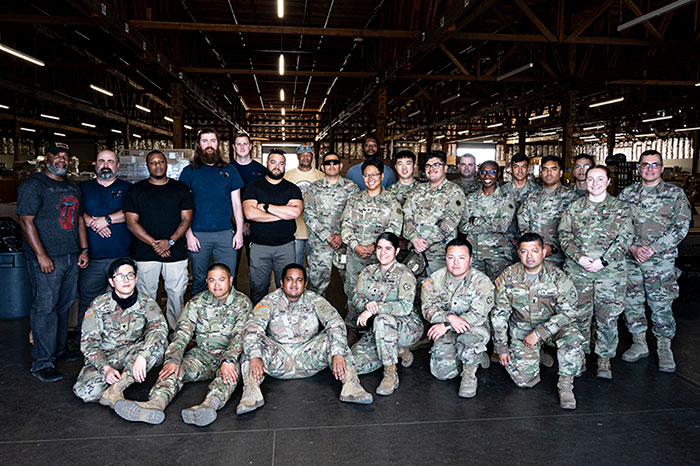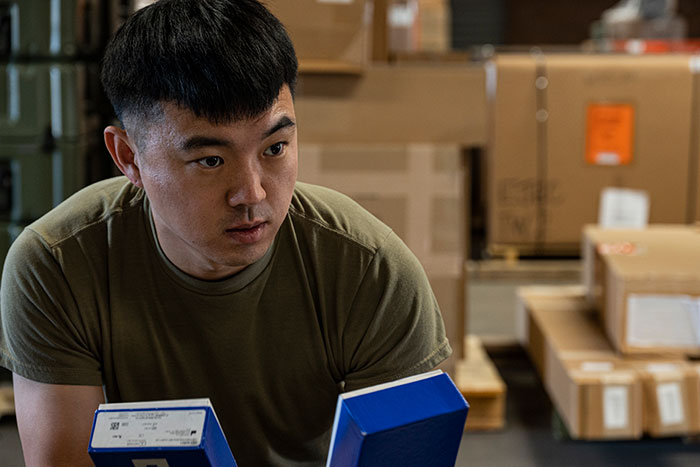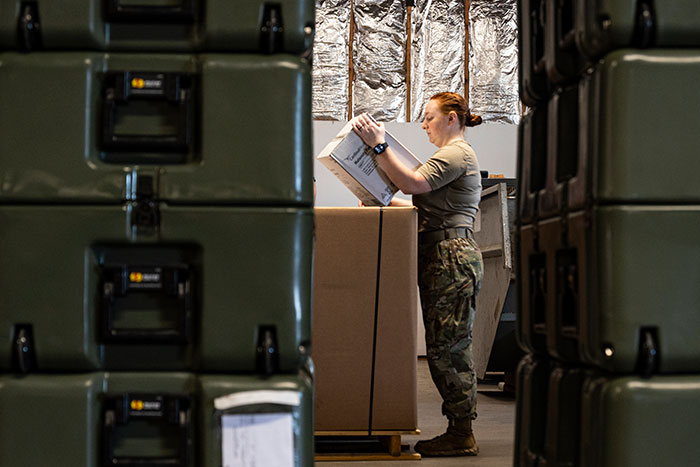USAMMDA logisticians, Reserve Soldiers, Army logistics support capstone hospital conversion effort in Northern California's high desert

The U.S. Army Medical Materiel Development Activity, partnering with the Army Reserve's 807th Medical Command (Deployment Support), reached a milestone in its yearslong efforts to support U.S. Army Reserve medical commands last week, starting the final Hospital Conversion at Sierra Army Depot, California.
Phase one of the conversion of the Combat Support Hospital to the Hospital Center construct started July 16 at SIAD, an arid outpost at the north end of the Sierra Nevada mountains, 50 miles north of Reno, Nevada. Once completed later this summer, the conversion will equip the eight Army Reserve medical commands belonging to the 801st Combat Support Hospital.
During the fielding, logisticians with USAMMDA's Force Sustainment Directorate (FSD) are partnering with stakeholders from across the U.S. Army medical development realm and the 807th MCDS to plan, rehearse, and supervise the conversion at SIAD, according to Rufus Pruitt, a logistics management specialist with USAMMDA's FSD, originally from Carrollton, Alabama.
"We received 19 containers of equipment delivered by the Defense Logistics Agency from Hill Air Force Base, and 15 pallets of new build materials for this conversion," said Pruitt, who is supervising both the USAMMDA fielding team and Reserve Soldiers during the conversion. "We're out here to do the inventory of all the new growth sets for this first phase of the conversion."
For the conversion effort, which includes an inventory of all medical equipment, supplies, and materiel delivered to SIAD, Army Reserve Soldiers from across 807th MCDS joined the USAMMDA FSD fielding team to unload, open, sort and count thousands of individual items. After each item is counted, recorded, and sorted, it is stored in designated containers for possible later use by medical providers belonging to the 801st CSH.
"The conversion is a combination of upgrades, where we will combine new equipment from the delivery with items that are on-hand at SIAD, take away excess equipment, and then store for the 801st CSH," said Pruitt. "Hospital conversions and fieldings are important because [SIAD] has contingency stock, the equipment that a deploying unit can use to fill any shortages prior to the deployment. These inventories take place to make sure that the materiel here on-hand is ready to go when it's needed."
USAMMDA, based at Fort Detrick, Maryland, is the U.S. Army's premier medical development command, and its staff works to equip U.S. Joint Force medical providers in both the Active Duty and Reserve forces. USAMMDA team members partner with the Department of Defense, medical development industry, and academic stakeholders to develop new drugs, vaccines, devices, and medical support equipment to help preserve and protect the lives of U.S. Warfighters.

One of USAMMDA's most vital functions is working with end-user commands to assess materiel needs and field solutions that meet medical command readiness requirements for training and operations across the globe, according to Rick Bower, the FSD fielding division chief with USAMMDA.
"These fieldings and conversions help maintain readiness, not only for the Reserve medical commands, but for any unit that could be called upon to draw this equipment in case of a deployment," said Bower, a retired Army medical logistics specialist who has been with FSD since 2006. "Whether it is a natural disaster or real-world operation, it's important for the Soldiers to get hands-on time with the equipment they could possibly be using."
The fielding of new medical equipment, devices, and technologies is a routine year-round effort for the FSD fielding team. Regional managers and contract staff average 200 or more days at sites each year, with more than 450 individual fieldings annually to provide some $54 million of new medical equipment to service members stationed across the world. The 801st CSH-to-Hospital Center conversion fits into the wider U.S. Army medical readiness strategy to prepare for 2030, 2040 and beyond, said Bower, who is originally from Williamsport, Pennsylvania.
"Our strategy is to field new materiel, whether it is in the continental United States, outside the U.S., or in austere environments," across the world, said Bower. "We outfit the Warfighters with the most current material available. I'm proud that we can give back to the Warfighters and provide them with the new materiel that they can go to war with."
The U.S. Army Reserve medical arm is a vast organization and carries a large proportion of the Army's medical capabilities. Reserve Soldiers are ready at a moment's notice to respond in case of National disasters or world crises. The 801st CSH-to-Hospital Center conversion is part of a longstanding relationship between the Reserve medical community and the medical development and logistics teams in the Active-Duty force, said Col. Neil Thowe, deputy chief of staff for logistics with the 807th MCDS.

"Most of the Army's deployable medical force is in the Army Reserve," said Thowe, who enlisted in the Army as a private more than 30 years ago. "To see the 807th MCDS and USAMMDA working closely together on medical fielding initiatives is a realization of the vision established by [Maj. Gen. Tracy Smith, 807th MCDS commanding general] when she took command. To see her vision physically manifested and to see the positive benefits for the Soldiers and unit readiness has been a rewarding experience."
Like most Reservists, the 807th MCDS Soldiers perform drill on a periodic basis throughout the year. The conversion efforts at SIAD will allow the 807th MCDS Reserve Soldiers to see and support a collaboration with wide-reaching strategic impact, said Thowe.
"The CSH-to-Hospital Center conversion project here at SIAD provided several great training opportunities for Soldiers, including troop leadership and inventory processes," said Thowe, who is originally from Kansas City, Missouri. "The Soldiers will learn more about USAMMDA and USAMMA and how the Medical Materiel Readiness Program fits into the medical equipping strategy for U.S. Army. I do not recall many opportunities like this, when I was a junior enlisted, to understand how my work nested into the larger strategic picture. This is a unique opportunity for the 807th Soldiers to see different echelons of Army medicine, from tactical to operational and through strategic, and how they fit together and contribute to strategic readiness."













